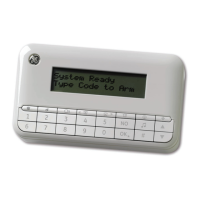NetworX Version 3 Installation Manual
71
Location Term Definition
2.1.1.1.3 Partitions A menu entry that lists the partitions assigned to the
selected zone. The selected zone can trigger an event on
these partitions.
A zone may reside in any combination of partitions. A zone
that resides in more than one partition becomes a
common zone and is reported to its lowest partition
number. A common zone is armed only when all the
partitions that it belongs to are armed. It is disarmed the
moment one of the partitions it belongs to is disarmed.
2.1.1.1.4 Copy Zone A menu option that copies the settings for an individual
zone to a contiguous set of other zones.
2.1.2 Swinger Count A zone characteristic that includes the selected zone in the
swinger counter for an partition. Each partition has a
swinger counter, and every zone trip in that partition
increments the swinger count for that partition. When the
count reaches the programmed number of trips, the panel
bypasses the last tripped zone and clears the counter.
An Inputs menu entry that contains the swinger count.
2.1.3 Zone Types A menu entry that groups zone type characteristics and
allows the installer to select a pre-defined zone type. There
are 30 pre-defined zone types. The characteristics of each
zone can be changed. For example, if a keypad beeps, if
the zone is a delay 1 or delay 2 zone, a 24-hour zone and
so on.
2.1.3.1.1 Input Type A menu entry that groups options that determine the basic
features of the selected zone type.
2.1.3.1.1.1 Fire A zone type that reports a fire alarm when activated.
2.1.3.1.1.2 24-hour A zone type where reaction is not dependent on the
arm/disarm state of the system. It is permanently active 24
hours a day unless bypassed by forced arming. An
example of a 24-hour zone is a fire, panic or glassbreak
zone.
2.1.3.1.1.3 Keyswitch A zone type that can be used to arm or disarm a partition
using a switch connected to a zone instead of a code. Both
pulsed and maintained keyswitches can be used.
2.1.3.1.1.4 Delay 1 A zone type whose events can be delayed for a specified
interval before a zone creates an alarm. This type of zone is
usually used to allow exit and entry to a building. The time
intervals for a Delay 1 zone are defined in Entry 1 and Exit
1.
2.1.3.1.1.5 Delay 2 A zone type whose events can be delayed for a specified
interval before a zone creates an alarm. This type of zone is
usually used to allow exit and entry to a building. The time
intervals for a Delay 2 zone are defined in Entry 2 and Exit
2.
2.1.3.1.1.6 Interior A zone type that is automatically bypassed when the
system is armed in stay mode.

